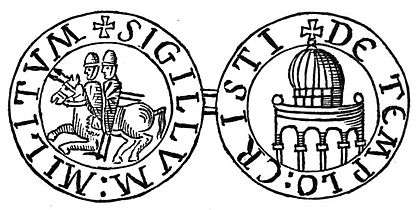Templum Domini
Coordinates: 31°46′41″N 35°14′07″E / 31.7781°N 35.2353°E


The Templum Domini (Vulgate translation of Hebrew: הֵיכָל יְהֹוָה "Temple of the Lord") was the name attributed by the Crusaders to the Dome of the Rock in Jerusalem.[2]
History
Islamic conquests
The Dome of the Rock was erected in the late 7th century under the 5th Umayyad Caliph Abd al-Malik ibn Marwan at the site of a Roman tempel and the former Jewish Second Temple, following the Islamic conquest of the Levant after the emergence of Islam in the Arabian peninsula.
Kingdom of Jerusalem
After the capture of Jerusalem in the First Crusade (1099), the Dome of the Rock was given into the care of Augustinian Canons Regular, who turned it into a Christian church.
The adjacent Al-Aqsa Mosque was called "Templum Solomonis ("Temple of Solomon") by the Crusaders. It first became a royal palace. The image of the Dome, as representing the "Temple of Solomon", became an important iconographic element in the Kingdom of Jerusalem. The royal seals of the Kings of Jerusalem depicted the city symbolically by combining the Tower of David, the Church of the Holy Sepulchre, the Dome of the Rock and the city walls.
Knights Templar
After the completion of the purpose-built royal palace near the Jaffa Gate, the King of Jerusalem gave the building to the Knights Templar, who maintained it as their headquarters. The Dome was indicated on the reverse of the seals of the Grand Masters of the Knights Templar (such as Everard des Barres and Renaud de Vichiers), and it became the architectural model for Templar churches across Europe.
The Dome of the Rock was lost with the Siege of Jerusalem by Saladin in 1187.
Today
Although the Dome of the Ascension survived from the Crusader period, it has since remained in the hands of Islamic authorities as part of the larger complex of Dome of the Rock.[3][4]
References
- ↑ drawing from T. A. Archer, The Crusades: The Story of the Latin Kingdom of Jerusalem (1894), p. 176. The design with the two knights on a horse and the inscription SIGILLVM MILITVM XRISTI is attested in 1191, see Jochen Burgtorf, The central convent of Hospitallers and Templars: history, organization, and personnel (1099/1120-1310), Volume 50 of History of warfare (2008), ISBN 978-90-04-16660-8, pp. 545-546.
- ↑ By Denys Pringle. «The Churches of the Crusader Kingdom of Jerusalem: Volume 3» page 403.
- ↑ Pawer, Jonathan (1996). The History of Jerusalem: The Early Muslim Period (638-1099). New YOrk University Press. p. 86. ISBN 0814766390.
- ↑ Simon Sebag Montefiore, Jerusalem: The Biography, p. 276.